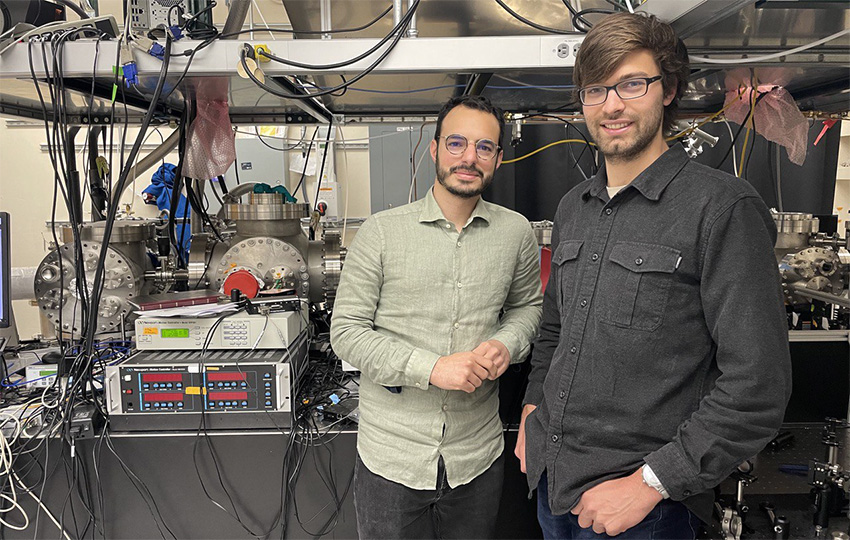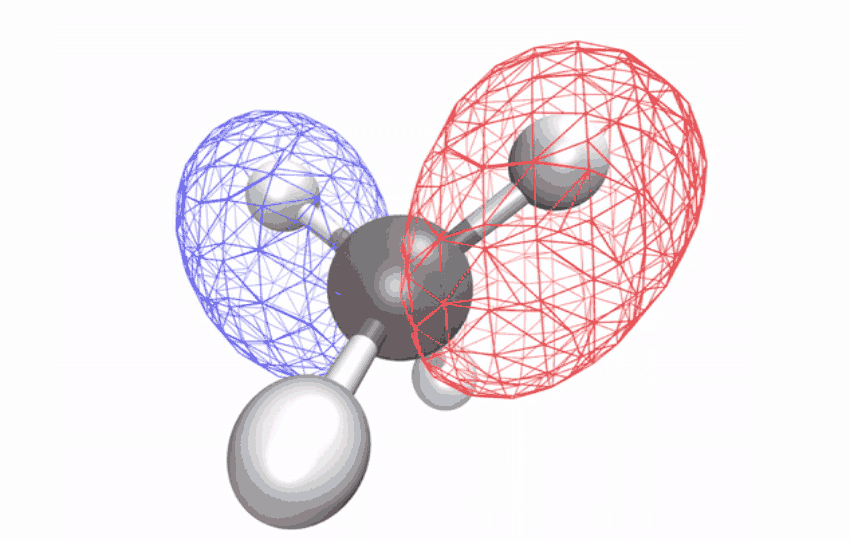Watching Molecules Relax in Real Time
An ultrafast x-ray imaging technique shows how the symmetry of methane’s structure evolves after rapid removal of an electron, providing insights into its physical and chemical properties.

Designing the next generation of efficient energy conversion devices for powering our electronics and heating our homes requires a detailed understanding of how molecules move and vibrate while undergoing light-induced chemical reactions. Researchers at the Department of Energy’s Lawrence Berkeley National Laboratory (Berkeley Lab) have now visualized the distortions of chemical bonds in a methane molecule after it absorbs light, loses an electron, and then relaxes. Their study provides insights into how molecules react to light, which can ultimately be useful for developing new methods to control chemical reactions.
“This research opens the door for studying more complex systems and other types of distortions.”
– Enrico Ridente
Examining how a molecule responds to light on extremely fast timescales allows researchers to track how electrons move during a chemical reaction. “The big question is how a molecule dissipates energy without breaking apart,” said Enrico Ridente, a physicist at Berkeley Lab and lead author on the Science paper reporting the work. This means examining how excess energy is redistributed in a molecule that has been excited by light, as the electrons and nuclei move about while the molecule relaxes to an equilibrium state.
Probing these fine-scale movements means making observations of processes that occur on timescales faster than a millionth of a billionth of a second. For decades, researchers have relied on theory to describe how excess energy affects the symmetry of – but does not break – the bonds of a molecule that’s been excited by light. This theory predicts how the bond lengths and angles between individual atoms should change while electrons shift position, and what intermediate structures it should adopt.
Now, using ultrafast x-ray spectroscopy facilities at Berkeley Lab’s Chemical Sciences Division, Ridente and his colleagues observed how the structure of ionized methane molecules evolves over time.
“Methane ions are an ideal system to address this question because they do not come apart when excited by light,” said Ridente.

By first using a laser to strip an electron from the neutral methane molecule, then taking ultrafast x-ray spectroscopic snapshots of the remaining ion, the researchers collected a time series of spectral signals. The signals revealed how the initially symmetric shape becomes distorted over a ten-femtosecond period (a femtosecond is one quadrillionth of a second) – observational evidence of a long-studied effect called Jahn-Teller distortion. Longer time observations showed that for another 58 femtoseconds, the distorted shape vibrates coherently in a scissoring-like motion while redistributing its energy via other vibrations through the structure’s geometric changes.
“Thanks to these measurements and the understanding gained from theory, we were able to time-resolve the full evolution of the distortion for the first time,” said Stephen Leone, a chemist at Berkeley Lab and the senior author on the Science paper.
The researchers used the Cori and Perlmutter systems at the National Energy Research Scientific Computing Center (NERSC), a DOE Office of Science user facility at Berkeley Lab, to perform calculations that confirmed their measurements of the molecule’s movements.
“We can now explain how the molecule distorts after losing an electron and how the energies of the electrons respond to these changes,” said Diptarka Hait, a graduate student at Berkeley Lab and the lead theoretical author of the study.
The study demonstrated the viability of an x-ray approach for studying ultrafast molecular dynamics. Methane is a fundamental yet simple molecule where one of the most basic types of distortions occurs as predicted, but with richer and more complicated dynamics than previously understood. “This research opens the door for studying more complex systems and other types of distortions,” says Ridente. Such insights about the dynamics of electrons and nuclei can lead to innovations in new energy conversion devices and photocatalysis applications.
This research was funded by the Department of Energy’s Office of Science.
